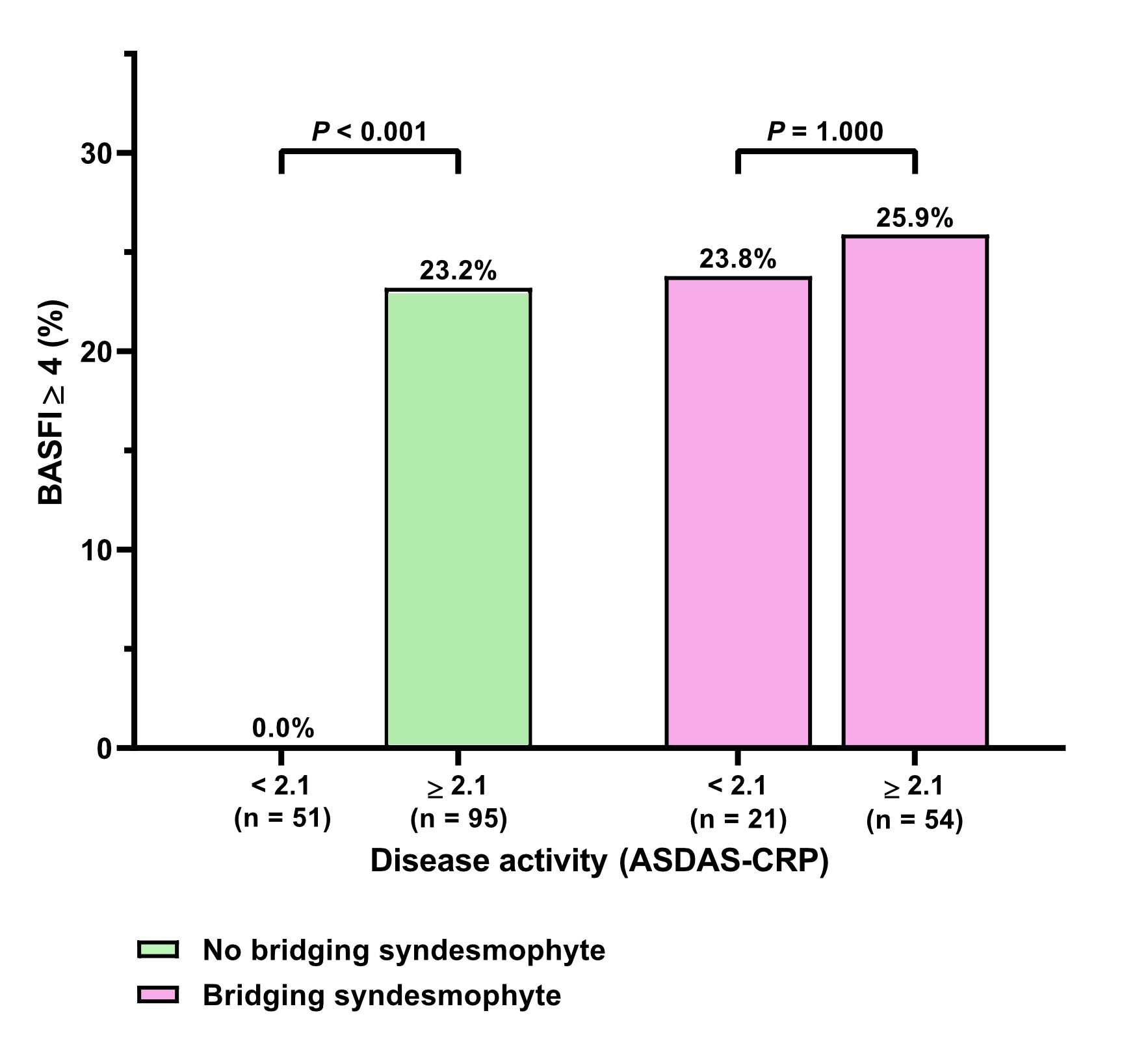Session Information
Session Type: Poster Session B
Session Time: 9:00AM-11:00AM
Background/Purpose: Although previous studies suggested that physical functioning is largely driven by disease activity in patients with spondyloarthritis (SpA), its relationship to radiographic progression has not been thoroughly investigated. The aim of this study was to investigate whether the effect of disease activity on physical function varies according to the radiographic progression in SpA patients.
Methods: This cross-sectional study used baseline data from the patients in a single-center, prospective cohort of SpA. Disease activity was assessed through Bath Ankylosing Spondylitis Disease Activity Index (BASDAI) and the Ankylosing Spondylitis Disease Activity Score (ASDAS). Physical function was measured using Bath Ankylosing Spondylitis Functional Index (BASFI) and functional impairment of the patients was defined as BASFI ≥4. Radiographic progression of SpA was assessed using modified Stoke Ankylosing Spondylitis Spine Score (mSASSS). Clinical factors related to functional impairment of the patient were investigated using logistic regression analysis.
Results: A total of 221 patients were analyzed. Mean (SD) age at baseline was 43.4 (14.1) yeas and 176 (79.6%) were male. Mean (SD) disease duration of the included patients was 7.5 (9.5) years. Remission or low disease activity (LDA, ASDAS-CRP < 2.1) was achieved in 149 (67.4%) patients. Mean (SD) mSASSS was 19.5 (20.6) and 96 (43.4%) patients had at least one syndesmophyte on baseline spinal radiographs.
At the baseline, functional impairment was present in 41 (18.6%) patients. Univariable analysis showed that older age at diagnosis, shorter disease duration based on two years, and higher ASDAS-CRP were associated with functional impairment. Although the effect of ASDAS-CRP on the outcome was consistent in the multivariable analysis (adjusted OR 2.46 [95% CI 1.70-3.58]), it was significantly different according to the severity of radiographic progression (P value for interaction = 0.001). In the absence of bridging syndesmophyte, increase in ASDAS-CRP was associated with more frequent functional impairment (adjusted OR 5.12 [2.61-10.05]). By contrast, in the subgroup of patients with bridging syndesmophyte, ASDAS-CRP did not increase the likelihood for functional impairment (adjusted OR 1.14 [0.70-1.86]). In fact, in the subgroup without bridging syndesmophyte, no patient with LDA showed a functional impairment. However, in advanced patients with bridging syndesmophyte, the rate of functional impairment was 23.8% despite achieving LDA. (Figure 1)
Conclusion: In the presence of advanced radiographic progression, low disease activity was not significantly associated with less functional impairment in patients with SpA, which suggests that early diagnosis and optimal treatment are critical for better physical function.
To cite this abstract in AMA style:
Jung J, Kim J, Park J, Lee E, Lee E, Park J. Impact of Disease Activity on Functional Impairment in Patients with Spondyloarthritis Is Different According to the Degree of Radiographic Progression: Result from SNUH-AS Cohort [abstract]. Arthritis Rheumatol. 2023; 75 (suppl 9). https://acrabstracts.org/abstract/impact-of-disease-activity-on-functional-impairment-in-patients-with-spondyloarthritis-is-different-according-to-the-degree-of-radiographic-progression-result-from-snuh-as-cohort/. Accessed .« Back to ACR Convergence 2023
ACR Meeting Abstracts - https://acrabstracts.org/abstract/impact-of-disease-activity-on-functional-impairment-in-patients-with-spondyloarthritis-is-different-according-to-the-degree-of-radiographic-progression-result-from-snuh-as-cohort/

